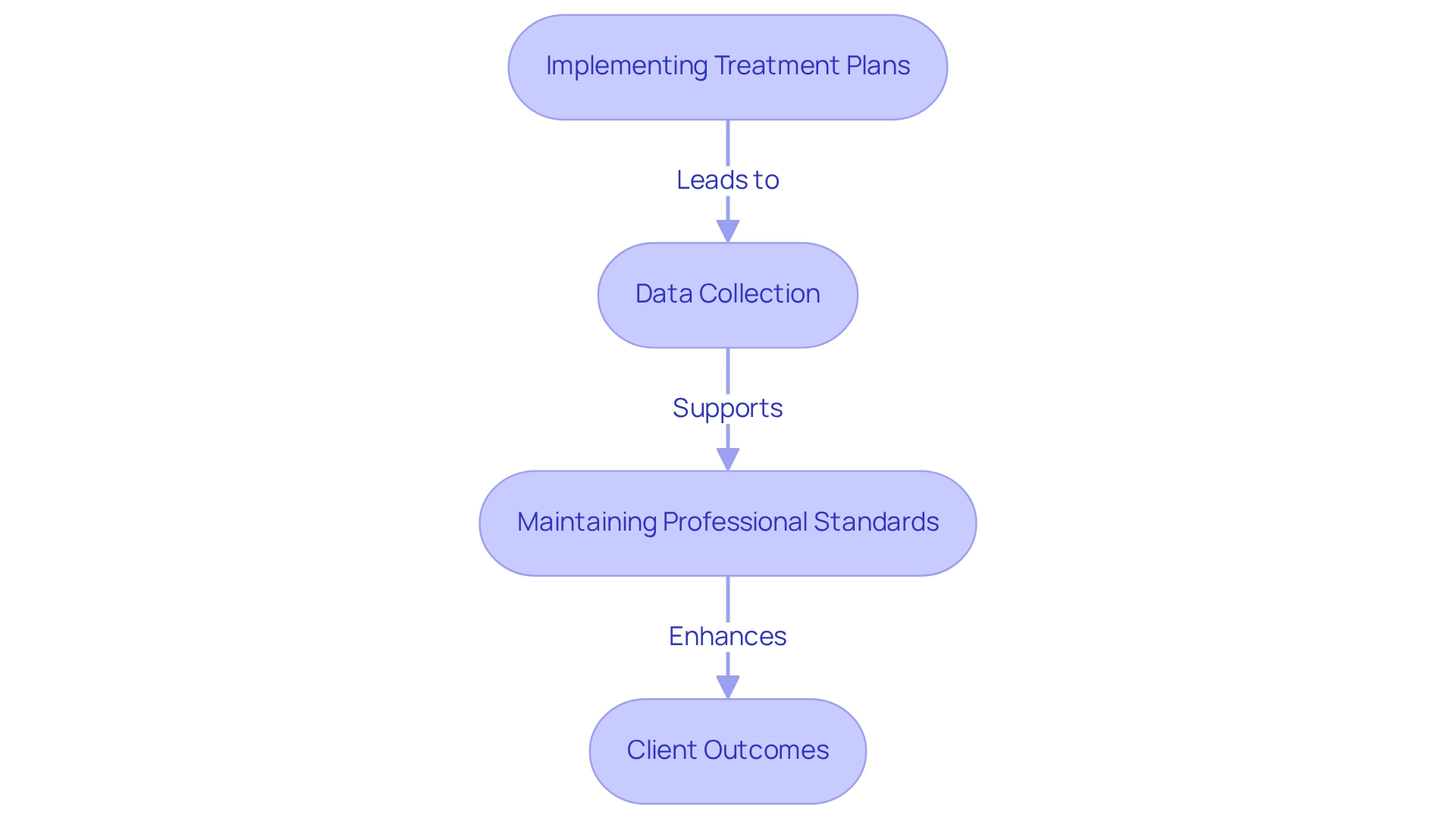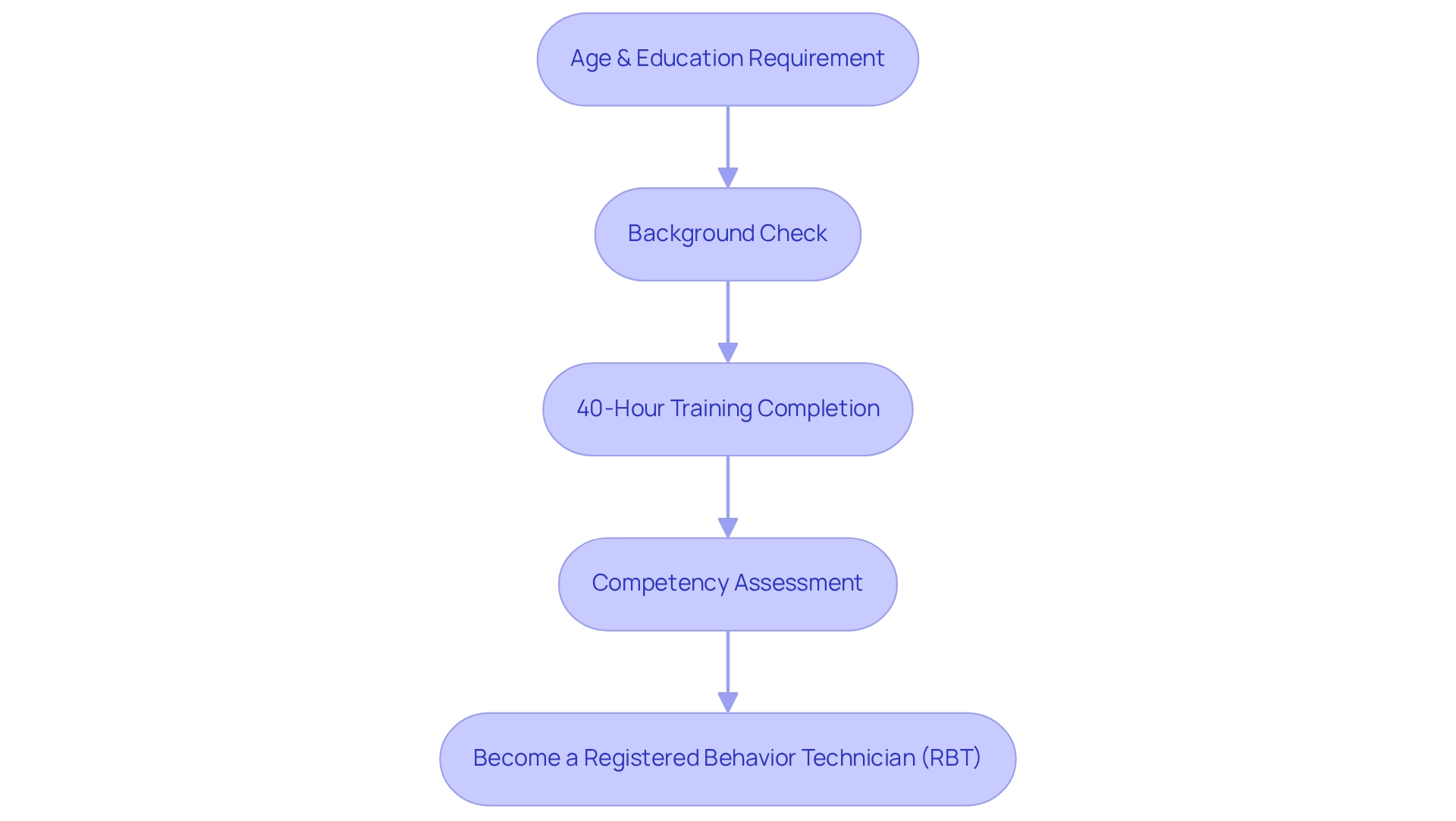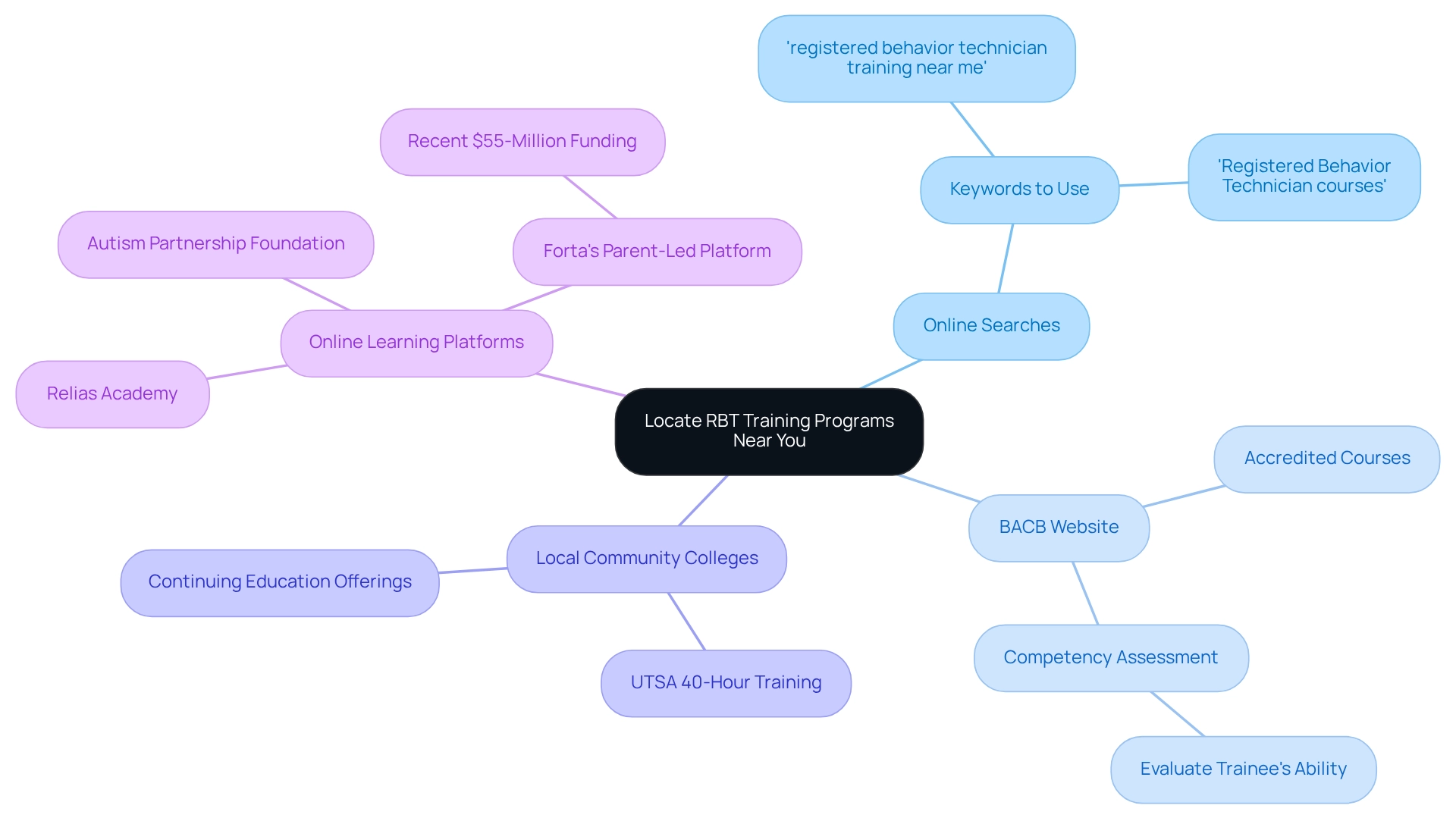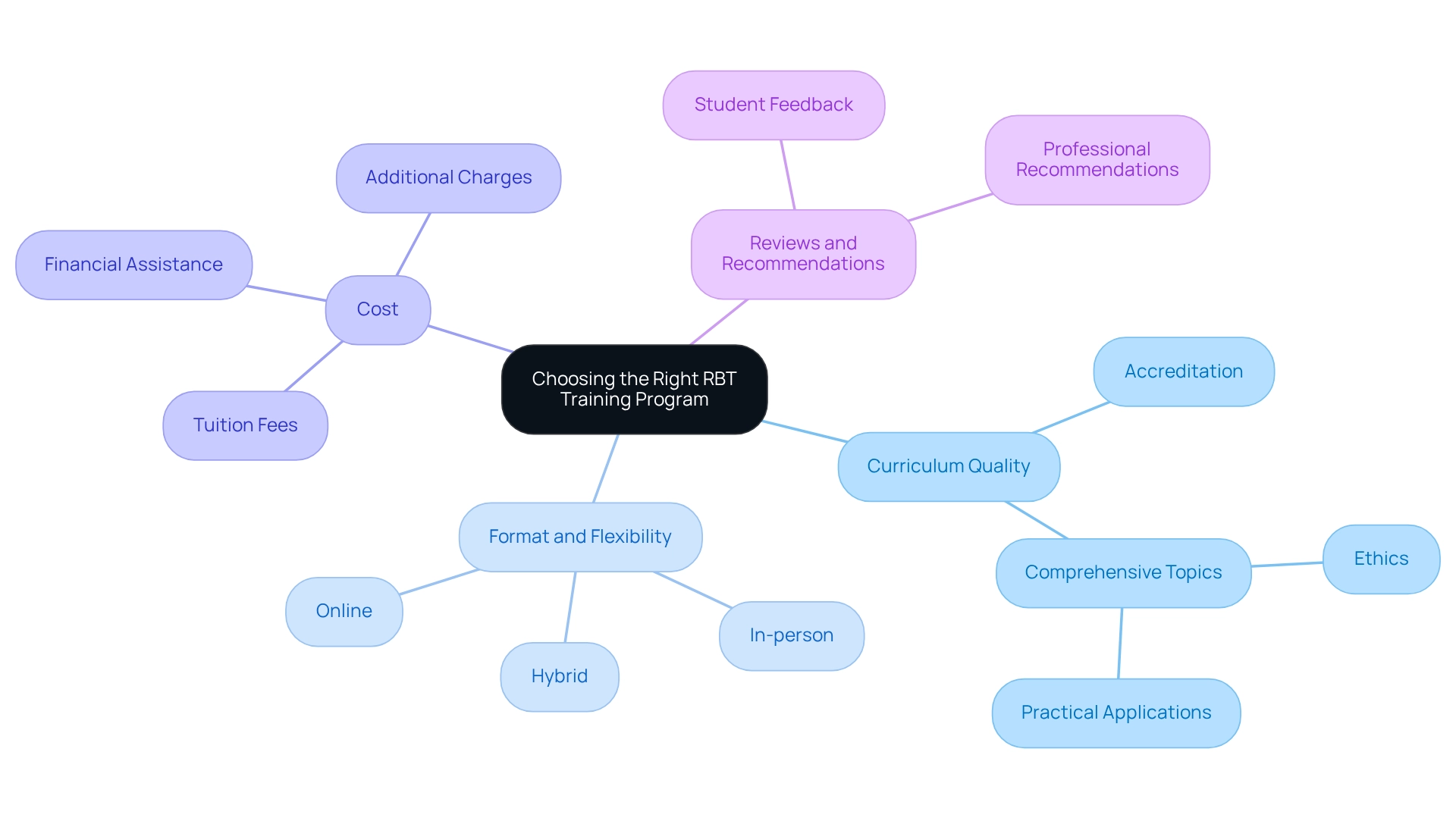June 1, 2025

To locate registered behavior technician training in your area, individuals should:
It is crucial to select educational courses that not only meet certification requirements but also ensure effective preparation for a career as an RBT. Evaluating factors such as curriculum quality, format, cost, and reviews is essential in making an informed decision. By prioritizing these elements, you can enhance your readiness and success in the field.
In the realm of behavioral therapy, the demand for Registered Behavior Technicians (RBTs) is surging, underscoring their pivotal role in supporting individuals with behavioral challenges, particularly those on the autism spectrum. As paraprofessionals, RBTs implement tailored treatment plans designed by Board Certified Behavior Analysts (BCBAs), ensuring that each client receives the personalized care they need to thrive. This rising demand highlights the importance of understanding the responsibilities, qualifications, and training pathways for this rewarding career in Applied Behavior Analysis.
Have you considered the impact that RBTs have on client outcomes? From hands-on data collection to maintaining ethical standards, RBTs not only enhance these outcomes but also contribute significantly to the growth of the field. This article delves into the intricacies of becoming an RBT, exploring training requirements, program selection, and the vital impact these professionals have on the lives they touch. By understanding these elements, you can better appreciate the essential role RBTs play in behavioral therapy.
A Registered Behavior Technician (RBT) plays a vital role as a paraprofessional, providing direct support to individuals facing behavioral challenges, particularly those with autism spectrum disorder (ASD). RBTs deliver behavior-analytic services under the supervision of a Board Certified Behavior Analyst (BCBA). Their responsibilities are critical and include:
For those interested in pursuing registered behavior technician training near me, understanding these responsibilities is imperative, as it helps them assess their interest and preparedness for the role, ensuring alignment with job demands. The need for registered behavior technician training near me is projected to surge, with an anticipated 16% increase in job opportunities from 2018 to 2028, as indicated by the job outlook for behavior technicians. This growth underscores the rising recognition of the importance of behavior technicians in executing effective treatment plans and improving client outcomes in autism treatment. Research has shown that ABA therapy, facilitated by trained professionals, is beneficial not only for individuals with ASD but also for those with conditions such as ADHD and Down syndrome. Each treatment plan is tailored to address the specific needs of clients, ultimately enhancing their quality of life. Furthermore, many ABA therapy programs actively promote parent involvement in treatment plans, which is crucial for achieving optimal outcomes. Grasping these responsibilities and the influence of RBTs on client outcomes is essential for prospective trainees, ensuring they are thoroughly prepared and aligned with the demands of this rewarding career path in ABA therapy.

To become a Registered Behavior Technician (RBT), candidates must undergo registered behavior technician training near me and fulfill specific qualifications that ensure they are equipped to support individuals with behavioral challenges effectively.
In 2021, the total count of practicing Registered Behavior Technicians reached 1,973, with a presence rate of 62.9%. This statistic highlights the growing demand for qualified professionals in the field. Furthermore, the importance of thorough background checks is emphasized by ABA professionals, who recognize that these measures are crucial for ensuring client safety and service quality.
As noted by Erick M Dubuque, could future research examining the supervision caseloads of BCBAs willing to provide supervision to RBTs yield a more precise understanding of the accessibility of ABA services? Additionally, the case study titled "Inequities in ABA Provider Accessibility" reveals significant geographic disparities in access to ABA services, particularly in rural and underserved areas. This underscores the need for targeted interventions to address these gaps.
The pathway to becoming an RBT includes registered behavior technician training near me, which is structured to ensure that candidates are not only knowledgeable but also capable of delivering high-quality care. As the field of Applied Behavior Analysis continues to expand, understanding these requirements is vital for stakeholders aiming to enhance service accessibility and effectiveness.

Locating registered behavior technician training near me can be achieved through several effective channels. Begin your online searches using search engines with keywords like 'registered behavior technician training near me' or 'Registered Behavior Technician courses' to uncover local options. This approach often yields a diverse array of results tailored to your geographic area.
By leveraging these resources, aspiring RBTs can effectively identify development courses that align with their professional aspirations and personal obligations. With the number of accredited RBT courses in the U.S. expected to grow, individuals will have an expanding selection of options in 2025. The rising demand for behavior analysis services emphasizes the importance of understanding the prerequisites for RBT certification, ensuring that individuals are well-prepared for their roles.

When selecting an RBT training program, it is crucial to consider several key factors, such as finding registered behavior technician training near me and verifying that the program is accredited by the BACB or recognized by reputable organizations in the field of ABA. Accreditation is essential as it guarantees that the course meets established standards of quality and effectiveness.
Moreover, it is important to acknowledge that the median pass rate for the RBT exam stands at 80.4%, underscoring the effectiveness of well-structured educational programs. Many aspiring RBTs face challenges in preparing for the exam due to varying access to registered behavior technician training near me and quality education resources. Addressing these challenges through improved preparation and resource availability can enhance candidates' readiness for the RBT exam.
By meticulously evaluating these factors, candidates can identify a training program that not only equips them for a successful career as an RBT but also contributes to the increasing demand for qualified professionals in the field of Applied Behavior Analysis.

The role of a Registered Behavior Technician (RBT) is pivotal in the realm of behavioral therapy, especially for individuals navigating challenges like autism spectrum disorder. RBTs play an essential part in executing tailored treatment plans, gathering critical data, and upholding ethical standards, all of which are integral to the success of Applied Behavior Analysis (ABA) therapy. As the demand for RBTs continues to rise, grasping their responsibilities and the qualifications required to enter this field becomes increasingly crucial.
To embark on the journey of becoming an RBT, candidates must fulfill specific requirements, including age, education, and completion of a comprehensive training program. This structured pathway not only equips individuals with the knowledge necessary to support clients effectively but also guarantees the delivery of high-quality care. With the emergence of accredited training programs, aspiring RBTs have unprecedented opportunities to pursue this rewarding career.
Selecting the right training program is vital for success in this field. Factors such as accreditation, curriculum quality, and flexibility should be meticulously assessed to ensure candidates are well-prepared for the RBT exam and their future roles. As the landscape of ABA therapy evolves, the influence of well-trained RBTs on client outcomes cannot be overstated. By investing in their education and training, individuals can meet the growing demand for qualified professionals committed to enhancing the lives of those with behavioral challenges.
What is the role of a Registered Behavior Technician (RBT)?
An RBT plays a vital role as a paraprofessional, providing direct support to individuals facing behavioral challenges, particularly those with autism spectrum disorder (ASD). They deliver behavior-analytic services under the supervision of a Board Certified Behavior Analyst (BCBA).
What are the main responsibilities of an RBT?
The main responsibilities of an RBT include implementing individualized treatment plans crafted by BCBAs, collecting data on client progress and behavior, and maintaining professional standards and ethical guidelines in interactions with clients and their families.
How do RBTs implement treatment plans?
RBTs execute treatment plans that focus on enhancing social, communication, and daily living skills, ensuring that the approach is tailored to meet the unique needs of each client, especially those with developmental disabilities.
Why is data collection important for RBTs?
Data collection is critical for evaluating the effectiveness of interventions. It guides treatment modifications and supports the overall success of Applied Behavior Analysis (ABA) therapy.
What ethical standards must RBTs uphold?
RBTs are required to uphold ethical guidelines and demonstrate professionalism in all interactions, which fosters trust and collaboration in therapeutic environments.
What is the job outlook for Registered Behavior Technicians?
The job outlook for Registered Behavior Technicians is projected to increase by 16% from 2018 to 2028, reflecting the rising recognition of their importance in executing effective treatment plans and improving client outcomes in autism treatment.
Who can benefit from ABA therapy facilitated by RBTs?
ABA therapy facilitated by trained professionals, including RBTs, is beneficial not only for individuals with autism spectrum disorder (ASD) but also for those with conditions such as ADHD and Down syndrome.
How does parent involvement affect ABA therapy outcomes?
Many ABA therapy programs promote parent involvement in treatment plans, which is crucial for achieving optimal outcomes for the clients.
Why is it important for prospective trainees to understand the responsibilities of RBTs?
Understanding the responsibilities of RBTs helps prospective trainees assess their interest and preparedness for the role, ensuring alignment with job demands and enhancing their readiness for this rewarding career path in ABA therapy.
Our expert recruitment strategies and AI-driven sourcing ensure that you receive top-notch candidates quickly, without compromising on quality. Whether you’re looking for BCBAs, Clinical Directors, or RBTs, we’ve got you covered.